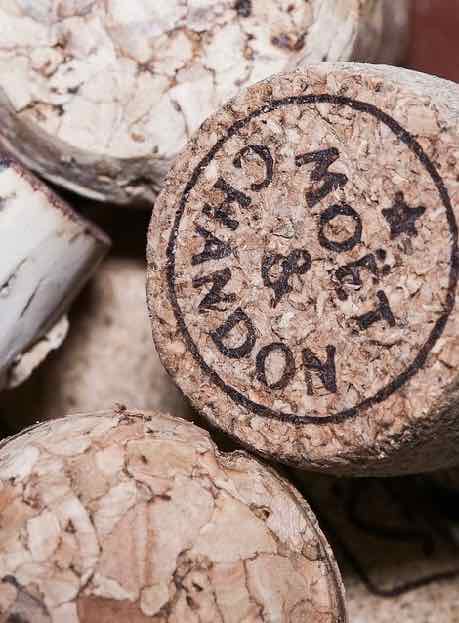If you don’t pay attention, you might think that there is only one type of champagne…It is not the case at all! Here are the different styles of Champagne you can find…

Most of the champagne you can find in the market are blends of the 3 grape varietals.
However, here are some terms you can find on labels, indicating you which grape has been used:
– Blanc de blancs: blanc means white so it is a white wine made with white grapes… Meaning it is a 100% Chardonnay resulting in an elegant and crispy champagne with floral and citric notes…
– Blanc de noirs: a white wine made with black grapes… It will be a Champagne made only with Pinot Noir or/and Meunier, with more power and red fruit aromas.
The area of Champagne has been divided into 320 different “crus”, corresponding to a winemaking village, with very different attributes (soil, climate & grape).
Those crus are ranked on 3 levels: cru, premier cru and grand cru (the best – and most expensive – grapes come from a grand cru)
Most of the champagnes you can find are white, even if they were made with black grapes! Why? All the (red) colour of a grape is in the skins. So if you use a thin-skinned varietal (like Pinot Noir or Meunier) and press it with very little contact with the skins, the juice will be white!
Did you know? A young and light champagne will be quite clear whereas an older and more powerful champagne will be deeper in colour!
What about rosé champagne, a fast growing trend?
In the region, there are two ways of making rosé: the first one is called “maceration”, where the skins are in contact for a while with the juice and will colour the wine (method mostly used for small batch cuvees made by winegrowers).
The second method, is called the assemblage (blending) and is only allowed in Champagne, to allow producers to make consistent wines. It’s just a mix of white wines with a small percentage (5-10%) of red wine made in Champagne!
The most popular type of champagne is the non-vintage (NV), or non millésimé (NM) in french, with no reference to the year of harvest. As the quality of the harvest can be very different from one year to another, in order to be able to make a consistent wine (the same wine every year) producers are allowed to blend juices from different harvests.
The minimum ageing time for a non-vintage champagne is of 15 months but in reality, most producers will age them for 2-3 years
For exceptional harvests, producers might decide to release a “vintage”, or “millésimé” champagne. This means that all the grapes harvested to produce it will come from the year specified on the label. This type of champagne is usually more expensive and produced on lesser quantities.
The minimum ageing time for vintage champagne is 3 years and in average 4-10 years.
Most producers also have in their collection a “prestige” champagne, which are vintage champagne made only during outstanding harvests with the best plots of champagne. The most famous are Dom Pérignon, Cristal, Belle Epoque… and command very high prices, over 150€ per bottle usually, and age for at least 10 years.

One of the last steps in the champagne making process includes the addition of a dose of sugar before shipping the bottle. The amount of sugar added will define the style of the Champagne, and will always be indicated on the label.
90% of the champagne you can buy is “brut” but there are other styles. Here is the scale of the different doses of residual sugar:
Brut Nature (or non dosé or zéro dosage) = no added sugar or less than 3 gr / litre
Extra-Brut = 0 – 6 gr sugar / litre
Brut = less than 12 gr sugar / litre
Extra Dry (Extra sec) = 12 – 17 gr sugar / litre
Dry (Sec) = 17 – 32 gr sugar / litre
Demi-Sec = 32 – 50 gr sugar / litre
Doux (Sweet) = more than 50 gr sugar / litre
| Cookie | Duration | Description |
|---|---|---|
| cookielawinfo-checkbox-analytics | 11 months | This cookie is set by GDPR Cookie Consent plugin. The cookie is used to store the user consent for the cookies in the category "Analytics". |
| cookielawinfo-checkbox-functional | 11 months | The cookie is set by GDPR cookie consent to record the user consent for the cookies in the category "Functional". |
| cookielawinfo-checkbox-necessary | 11 months | This cookie is set by GDPR Cookie Consent plugin. The cookies is used to store the user consent for the cookies in the category "Necessary". |
| cookielawinfo-checkbox-others | 11 months | This cookie is set by GDPR Cookie Consent plugin. The cookie is used to store the user consent for the cookies in the category "Other. |
| cookielawinfo-checkbox-performance | 11 months | This cookie is set by GDPR Cookie Consent plugin. The cookie is used to store the user consent for the cookies in the category "Performance". |
| viewed_cookie_policy | 11 months | The cookie is set by the GDPR Cookie Consent plugin and is used to store whether or not user has consented to the use of cookies. It does not store any personal data. |

